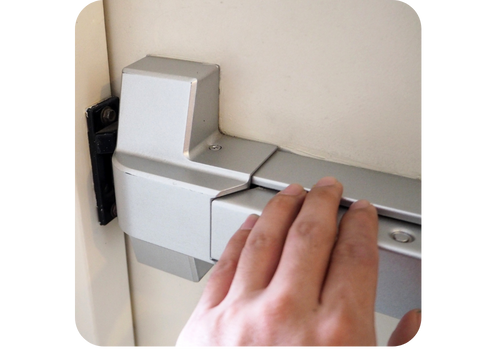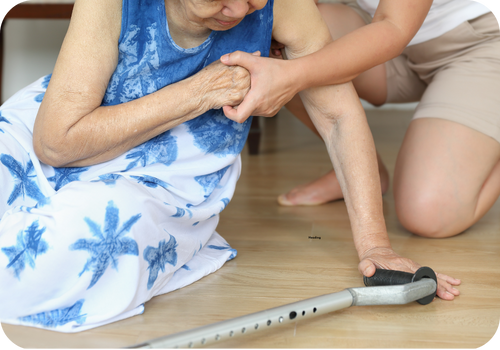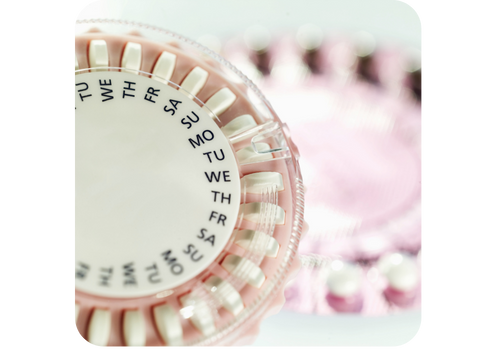Home > Living Well with Dementia > Technology improves quality of life

On this page:
| 1. Anti-Wandering Technology | 3. Feeding Aids and Oral Care |
| 2. Fall Detection Technology | 4. Medication Management / Medication Aids |

Anti-Wandering Technology
Wandering is common among individuals with dementia. As dementia progresses, individuals may experience confusion and disorientation, leading to wandering behaviours. Tracking technology can help locate individuals and minimize their risk of getting lost.
GPS Tracking Device
GPS tracking devices are a type of tracking technology. These devices generally come in two forms: personal GPS trackers and wearable GPS trackers.
Personal GPS trackers are portable devices that individuals can carry around.
Wearable GPS trackers are devices that can be embedded in daily accessories like smartwatches, pendants, and keychains.
Benefits of tracking devices:
- Ability to locate the individuals anywhere
- Allows continuous, 24/7 monitoring
Disadvantages of tracking devices:
- Privacy breaches may occur if set up improperly
Learn more about tracking devices
- University of Waterloo: Locator devices for people at risk of going missing
- Alzheimer Society of Canada: Tracking devices
Examples of tracking devices:
GPS trackers

Door Exit Alarms
Individuals with dementia may experience confusion and disorientation, so they may be at risk of wandering or trying to leave the house. Door exit alarms can help signal to their caregivers or others around that they need assistance.
These alarm systems can be installed on doors or windows. When individuals exit the room, the alarm system will be triggered.
Some alarm systems make a loud noise when triggered, notifying caregivers or others around. Other systems, such as remote notification alarms, notify caregivers with a sound away from the door to avoid startling the person inside.
Benefits of door exit alarms:
- Easy installation
- Fairly affordable
Disadvantages of door exit alarms:
- False alarms may be triggered when doors jiggle
Learn more about door exit alarms
- HOHOLIFE好好生活: 無線開門警報器(2)一長者防走失小工具 (Cantonese)
- Our Parents: Limit wandering with a dementia door alarm
Examples of door alarm systems:
Fall Detection Technology
Falls are the major cause of serious injuries for older adults. To prevent seriously negative outcomes, fall detection devices can help by automatically detecting falls and triggering immediate emergency alerts to designated recipients like family members or professional response centres.
These wearable sensor devices can be embedded in watches, pendants, and clip-on devices. Some can also serve as a panic button that individuals can press to contact emergency services anytime.

Fall Detection Technology
Falls are the major cause of serious injuries for older adults. To prevent seriously negative outcomes, fall detection devices can help by automatically detecting falls and triggering immediate emergency alerts to designated recipients like family members or professional response centres.
These wearable sensor devices can be embedded in watches, pendants, and clip-on devices. Some can also serve as a panic button that individuals can press to contact emergency services anytime.

Fall Detection Sensors
Benefits of fall detection sensors:
- Able to detect falls
- Able to trigger emergency alerts automatically
- Able to wear them anywhere
- Able to locate where the fall occurs
- Allows continuous, 24/7 monitoring
Disadvantages of fall detection sensors:
- Cannot guarantee 100% fall detection accuracy
Learn more about fall detection sensors
- Toronto Grace Health Center: Remote Care Monitoring (contact your healthcare providers to see if you are eligible for free services)
Examples of tracking and fall detection devices:
GPS watches
- Apple Watch (Video)
- AngelSense GPS Watch (Video)
- Galaxy Medical Alert Mobile Watch System with GPS & Fall Protection (Video)
- Samsung Galaxy Watch (Video)
- SecurMedic SmartSAFE
- Theora Care Connect Wearable
- Tranquil GPS Tracking Watch (Video)
- Tranquil GPS Locator Watch
GPS trackers
Pendants and wristbands
- Galaxy Medical Alert Mobile Medical Alert
- Galaxy Medical Alert Mini Mobile System with Fall Detection
- LifeLine HomeSafe with Fall Detection
- Telus LivingWell Companion
- Telus Medical Alert Pendant
- Toronto Grace Health Centre Remote Care Monitoring Plus (RCM+)
- Life Assure Classic Home
- Life Assure Premium Mobile Plus
Sensor pads and mats
- Sammons Preston bed sensor pads
- Smart Caregiver bed sensor pads
- Smart Caregiver chair sensor pads
- Smart Caregiver floor sensor pads
Caregiver call systems

Feeding Aids and
Oral Care
As an individual’s dementia progresses, they may experience challenges with swallowing, remembering to eat, and eating without dropping food. As such, individuals with dementia often experience difficulty in self-feeding.[1]
Food intake challenges may result in increased risk of mortality, malnutrition, and respiratory infections. Feeding aids can help individuals with safer independent feeding and prevent negative outcomes.
It is important to consult healthcare providers to determine the most appropriate feeding assistance approach, as the decisions should involve swallowing ability assessments and related risks.
There are two major types of feeding aids: manual aids and electrical and robotic aids.

Feeding Aids and Oral Care
As an individual’s dementia progresses, they may experience challenges with swallowing, remembering to eat, and eating without dropping food. As such, individuals with dementia often experience difficulty in self-feeding.[1]
Food intake challenges may result in increased risk of mortality, malnutrition, and respiratory infections. Feeding aids can help individuals with safer independent feeding and prevent negative outcomes.
It is important to consult healthcare providers to determine the most appropriate feeding assistance approach, as the decisions should involve swallowing ability assessments and related risks.
There are two major types of feeding aids: manual aids and electrical and robotic aids.

Manual aids
allow users to self-feed with the support of non-electrical aids.
Examples of manual aids:
Adapted cutlery
- BunMo Weighted Utensils
- The Celly Utensils
- Eat Well Tableware
- Parson ADL Tableware and Accessories
- Sure Grip Utensils
Gripping aids
Mobile arm supports / Assisted feeders
- Jaeco Original Mobile Arm Support (Training and consultation services)
- Jaeco Elevating MultiLink Mobile Arm Support (Video)
- Jaeco Forearm Support with Offset Swivel and Slide
- Jaeco Suspension Mobile Arm Support
- Performance Health Stable Slide Self-Feeding Support
- Sammons Preston Mobile Arm Support with Elevation Assist

Electrical and robotic aids
are power-assisted devices that help people move their arms, or robotic arms, to their mouths. These devices are mostly controlled by switches or a joystick.
Benefits of feeding aids:
- Increase individual’s independence, confidence, and dignity
- Reduce the risk of malnutrition
Disadvantages of feeding aids:
- Assistive feeding devices and installation services can be costly
- Some devices have strict maintenance requirements
- Use of devices may require supervision and assistance from caregivers
Examples of feeding aids:
Motorized levelling cutlery
Power-assisted mobile arm support
Robotic feeding devices

Medication Management / Medication Aids
Medication management, including remembering the correct time and dosage to take, can be challenging for individuals with dementia. Forgetting to take medication as prescribed can lead to serious health risks.

Medication Management / Medication Aids
Medication management, including remembering the correct time and dosage to take, can be challenging for individuals with dementia. Forgetting to take medication as prescribed can lead to serious health risks.

Automatic pill dispensers
Automatic pill dispensers can be a helpful tool to avoid missing medication.
Automatic pill dispensers work by dispensing the correct medication dose at pre-set times. The dispensers also alert users at pre-set times with sounds and blinking lights.
Some dispensers have mobile applications to allow caregivers to remotely keep track of whether individuals took medications and when. Pill reminders and missed-dose alerts can also be sent to the apps.
Benefits of automatic pill dispensers:
- Increase individuals’ independence, confidence, and dignity
- Reduce the risk of missed medication
Disadvantages of automatic pill dispensers:
- Can be expensive
- Caregivers may need to help set the device
- Caregivers may need to help refill the correct medication and dosage every cycle
- Some devices lack a backup power supply to sustain use in the event of a power outage
Examples of Products:
Automatic pill dispensers
- e-Pill Voice
- Hero (watch video overview)
- LiveFine
- Med Timer
- MedaCube (watch video overview)
- TabTime Medelert (watch )
- Pivotell (watch video overview)
Pill Organizer
- TabTime Super 8 (watch video overview)
References
[1] Jung, D., Lee, K., De Gagne, J. C., Lee, M., Lee, H., Yoo, L., Won, S., & Choi, E. (2021). Eating difficulties among older adults with dementia in long-term care facilities: A scoping review. International journal of environmental research and public health, 18(19), 10109. https://doi.org/10.3390/ijerph181910109
[2] Sarsby, S. (2020). The importance of assistive technology in feeding. AT Today. https://attoday.co.uk/the-importance-of-assistive-technology-in-feeding/
